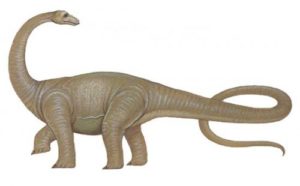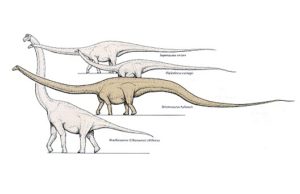Updated on: 28/03/2022
Supersaurus, a genus of sauropods, were one of the largest dinosaurs ever to walk the earth. It lived approximately 153 million years ago and its fossils were first discovered in Colorado in the upper Jurassic Morrison Formation in 1972.
| Kingdom: | Animalia |
| Phylum: | Chordata |
| Class: | Reptilia |
| Clade: | Dinosauria |
| Order: | Saurischia |
| Suborder: | Sauropodomorpha |
| Clade: | Neosauropoda |
| Family: | Diplodocidae |
| Sub-family: | Diplodocinae |
| Genus: | Supersaurus |
| Species: | S. viviane |
| Name Meaning: | Super Lizard |
| Geological Period: | Tithonian (Late Jurassic Epoch) |
| Size: | 33-34 m |
| Weight: | 35 – 40 tons |
| Average Lifespan: | 100 years |
| Location/Distribution: | Colorado, Portugal |
| Diet: | Herbivore |
| Birth Type (Reproduction): | Eggs |
| Locomotion: | Quadrupedal |

Their fossils were discovered in 1972 from the Dry Mesa Quarry and the exploration uncovered few bones including the shoulder girdle, as well as parts of the hip bone (ischium) and tail vertebrate. James A Jensen, a Paleontologist labeled the specimen in 1973, and later termed it as ‘Supersaurus.’ After more than a decade, it got officially recognized in 1985.
In 1996, a complete specimen was found in Wyoming and nicknamed ‘Jimbo,’which in 2007 was assigned to the genus Supersaurus. The Wyoming Dinosaur Centre now showcases a complete reconstruction of the specimen.
The Supersaurus looked like a whip-tailed giant that was 33 to 34 m long while its neck measured approximately 12 m. Studies indicate that its long neck may have had limited mobility. It had four legs each with five toes, just like elephants and its front legs were shorter than its back legs.
It is also believed that Supersaurus used its long whipped tail and thumb claws for defending themselves against predators.
For sustenance, Supersaurus used to rely only on plants. They had gastroliths inside their stomachs which helped in easy breakdown and digestion of large foliage. Most of the herbivores had blunt teeth, useful for stripping leaves.

Supersaurus used to travel in herds and migrate from one place to other when their local food supply became scarce. A linear pattern of laying eggs had been noticed, which indicates that they used to lay eggs while walking. It has also been assumed that sauropods did not take good care of their eggs so, most of the eggs couldn’t survive.